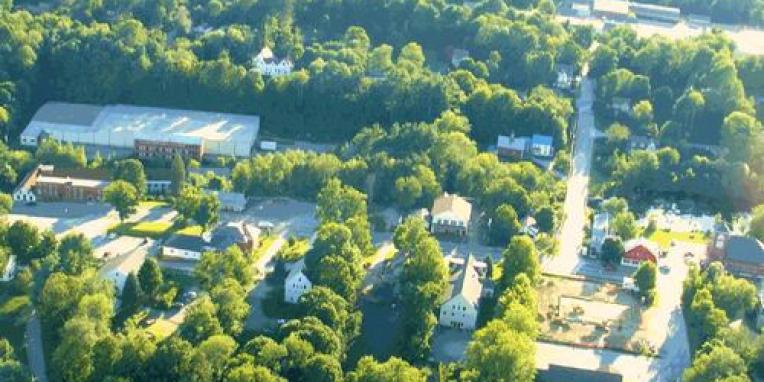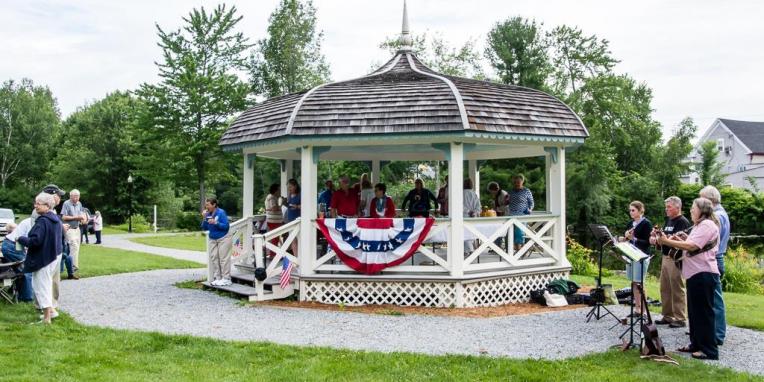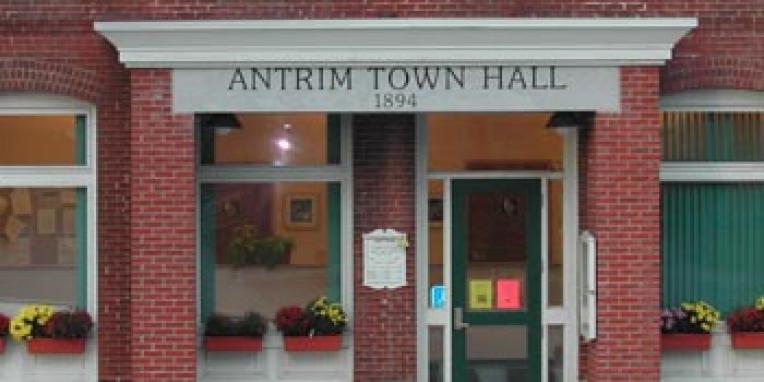Zoning Board of Adjustments
ZONING BOARD OF ADJUSTMENT
APPROVED MEETING MINUTES
December 8th, 2020
Public Hearing/Meeting
Members & Staff Present:
Shelley Nelkens (Member), Diane Kendall (Member), Christopher Parks (Alternate), Janet McEwen (Alternate), Carol Ogilvie (Planning Consultant participating by Zoom), and Ashley Brudnick-Destromp (Assistant participating by Zoom)
Absent: John Giffin (Chair), Ray Ledgerwood (Member), and Bob Holmes (Member)
Public Attendees: Mark Hetzer (Applicant), Chris Guida (Fieldstone), Helen Perivier (Self on Zoom), Joan Gorga (Self on Zoom), Amy Varnum (Self on Zoom), Jerome Shultz (Self on Zoom), Martha Osler (Self on Zoom).
*Due to COVID-19 this meeting was conducted with social distancing and also made available to public access via Zoom*
Opening of Meeting: Vice Chair Kendall opened the meeting at 7:00 PM
Roll Call Vote for Attendance: John Giffin- no answer, Diane Kendall, “Here,” Shelley Nelkens, “Here,” Bob Holmes-no response, Ray Ledgerwood- No response, Chris Parks, “Here,” and Janet McEwen, “Here.”
Vice Chair Kendall opened the continued Public Hearing at 7:03 PM. Mr. Parks and Ms. McEwen remained in their appointed positions from the previous Public Hearing.
- Public Hearing Continued: Mark Hetzer 2020-05 ZBA Map 241 Lot 027 (35 White Birch Point Road) Public Hearing for a dimensional variance from Article XI-A, Section 14.1 in order to construct a 304 square foot enclosed porch and a 150 square foot deck to an already non-conforming dwelling within the Shoreland Protection setback of 100 feet.
Vice Chair Kendall gave a brief overview of where they left off. She stated that each person who has not had an opportunity to speak yet will be allowed 5 minutes until 7:30PM. The Assistant confirmed with the Vice Chair there was no one in attendance in person other than the applicant, and read of the names of those participating by Zoom.
The Vice Chair asked if anyone on Zoom that hasn’t spoken yet wished to speak in support or in opposition, there was no answer. The Vice Chair then said anyone who has already spoken has the opportunity to speak again, there was no response. The Vice Chair reminded the participants this is the last opportunity to speak. There was no response.
Vice Chair Kendall said that she would now allow the applicants their final opportunity to speak again.
Mr. Guida introduced himself. He brought a copy of the Gregg Lake Action Plan and Watershed Management Plan that was done in cooperation with NHDES. It is Dated December 3, 2019. He said he had a chance to review it after the last Public Hearing. He said some of the primary contributors to pollution identified in the report were septic systems and storm water management. Mr. Guida believes they addressed all the items in the report, especially storm water management. He noticed that Mr. Hetzer’s property was one of the areas causing contamination in the report. A number of the letters he went over suggested he was in violation and sited NHDES. NHDES came out and inspected and the only violation was some of the cutting was done too short, but that it is already growing back and it’s also something that the Board felt additional blueberry bushes were something they wanted, the applicant is willing to do that as well since it is a native species. Mr. Guida said he spoke to a contact in Shoreland at NHDES about rain garden infiltration that was suggested, and gave a description of how that works. Mr. Guida said that his contact at NHDES said it would be great but not required by the State for the disturbance Mr. Hetzer was cited for. Mr.Guida said the contact told him It would allow for natural habitat to grow and be maintained and that if the Town makes it a condition, the State can do an amended Shoreland plan.
Mr. Guida mentioned that an accessory structure is allowed as an alternative by special exception if all set back requirements are met. He informed the board that if this application is denied, the owner would seek an accessory structure. This is a non-conforming house on a non-conforming lot that will require a variance for anything because of the property’s location. Mr Guida went over briefly on how the slopes, structure, and lot do not allow for another location for the deck. If Mr. Hetzer chose to build a new house, he would need approval but it would cause a lot more damage by removal of trees. Mr. Guida said that if the Board has any suggestions for what they would like to see, that the applicant might have missed, they are more than happy to hear those out.
Ms. McEwen said that one of her concerns was that there was a lot of vegetation that was cut down, and even with the blueberry bushes it would not make up for it. There was a lot of heavy mulching, and with that will there actually be regrowth? Mr. Guida said that it was necessary to gain access to the dock, and some people use crushed stone and others use mulch to prevent vegetation growing on your pathway. He added that some of the area is used for sitting and it is a limited space to use, but if there was a deck the chairs would go on the deck and not the ground. The area could be replanted if they have a deck and can remove the ground use. Mr. Guida gave a detailed explanation of how the clearing of vegetation works in regards to impact and need. He said that they don’t want it as overgrown as it was, but can bring some of it back. Ms. McEwen said it was cleared more than the pathway based off her recollection.
Vice Chair Kendall said that the matters of vegetation are enforced by NHDES and not the Town, and that it is not relevant to the variance of building on to this structure.
Mr. Parks asked the applicant if they would absolutely add rainwater protection to the plan as a condition. Mr. Guida responded yes, absolutely.
Ms. Nelkens and Vice Chair Kendall discussed how conditions can be added after a variance is granted. Ms.Nelkens asked Mr. Guida to go over the detail of the rain garden. He went over the process of installing a rain garden so that the organic layer gets removed and the reasons why as well as how the rain garden works. Ms. Nelkens asked about planting. Mr. Guida said there would be a native dogwood typically or something more shrub like depending on the size of the rain garden. Low bush blueberry or a conservation mix of high grass, something with root structure.
Ms. McEwen asked about the coloring on Mr. Guidas large scale plan, and what the different colors meant. Mr. Guida went over what was currently there and what is being proposed. He added NHDES will only allow a screened in porch.
Vice Chair Kendall closed the Public Hearing for this application and the Board moved into deliberation at 7:32 PM.
Deliberation:
For a variance to be legally granted, the applicant must show that their proposed use meets all 5 variances, and Vice Chair Kendall read the 5 variances.
Vice Chair Kendall read the definition of an unnecessary hardship from RSA 674:33,1(5)b provides the criteria for establishing an unnecessary hardship.
The Vice Chair wanted to go over the first criteria of the variance being not contrary to the public interest and asked if there was any discussion. There was a discussion on the variance and why it’s being requested and why it is there. This variance is to protect the water, and Vice Chair Kendall read the applicants responses to the first criteria. The Board members all discussed this. Mr. Guida added Public Opinion and Public Interest are two separate things. The specific objections were based on their feelings, not the construction technics. The concern was that there was a gut reaction. Vice Chair Kendall spoke on criteria 1 and 2, and read the definition on page 53 of the Shoreland Protection Ordinance, the minimum lot requirements, accessory structures, and primary structures. She added that accessory structures may be located within the 100ft setback as a special exception such as a gazebo. She stated that, if in the spirit of the ordinance, if a detached gazebo on the ground is allowed, it would conceivably have a greater impact and the same if not more square footage. She asked the Board how is a gazebo different then a deck? Ms. Nelkens spoke on her original concerns and asked since accessory structures is defined in the general ordinance and Shoreland Ordinance differently, which definition should they be considering. Ms. McEwen asked Ms. Ogilvie if there are any dimensional requirements for an accessory structure. Ms. Ogilvie said, “No,” in response to Ms. McEwen. In response to Ms. Nelkens, Ms. Ogilvie said that whichever definition is more stringent is the one applied, therefore it would be the definition in the Shoreland Ordinance especially since they are seeking a variance from Shoreland.
Vice Chair Kendall said that they are looking at a deck vs. a gazebo. Mr. Guida asked to clarify and Vice Chair Kendall allowed him. Mr. Guida went over the State’s requirements for accessory structures. The Board members continued to speak on concerns. Ms. Ogilvie went over their questions. The Board discussed how the Code Enforcement officer is in charge of enforcing conditions.
Vice Chair Kendall went through the criteria with the Board:
Criteria 1: Is this contrary to public interest? The board members all agreed it is not.
Criteria 2: Is it in the spirit of the ordinance observed? The Board went over the spirit of the ordinance. Vice Chair Kendall and the rest of the Board feel the spirit of the ordinance is observed.
Criteria 3: Substantial justice is done. Is the benefit greater than any harm? Vice Chair Kendall read the applicants response to criteria number 3 for the Board. The Board asked Mr. Guida some questions in regards to the vegetation. Mr. Hetzer addressed the Board on how he has spoken to NHDES already, and his plans for a flower garden and vegetation. Mr. Guida spoke on the dimensions of the deck and distance from the shore. Vice Chair Kendall said that she believes substantial justice is done. The rest of the Board agreed.
Criteria 4: The values of the surrounding properties are not diminished. The Board said it was clear it would not.
Criteria 5: Literal enforcement of the ordinance would result in unnecessary hardship. Vice Chair Kendall read the 2 different ways that an unnecessary hardship is determined. The Board discussed this in great detail. Vice Chair reminded the Board if this is denied, the applicant can come back for a gazebo by special exception, and could potentially have a greater impact as it is on the ground and would need to be walked to by a pathway. Vice Chair Kendall mentioned a gazebo would require more impact and activity as well as disturbing more plants, and that a deck with a screen porch has less impact in her opinion. She informed the Board that because they are coming to the ZBA to put a deck in, they are putting in their plans complete storm water management which we don’t know if they would do if they were constructing a gazebo. If the variance is granted the Board can attach conditions that are reasonable and enforceable. A conditional use permit is issued by the PB and not the ZBA. There was a quick discussion on environmental expertise and attaching conditions. There was a discussion on Peter Beblowski’s comments as Chair of the Conservation Commission, and how they do not have the authority to enforce but can make a recommendation. There was further discussion on how the applicant could come back for a gazebo by special exception. Ms. Ogilvie said the applicant is allowed to come back for a gazebo if they wanted to, and that each case and application is different and separate.
Vice Chair Kendall asked Ms. Ogilvie if they were considering hardship correct. Ms. Ogilvie said that she believes the Vice Chair characterized all of the hardship scenarios correctly. Vice Chair Kendall asked Ms. Ogilvie if a motion is made, do they grant the variance with the conditions applied. Motion would be made subject to conditions that could be discussed and then voted on. The motion can always be amended. The Board decided to discuss the conditions prior to the motion being made.
The Board discussed the conditions if approved. Proper vegetation was discussed and a rain garden to allow proper drainage. Mr. Parks mentioned that the applicant has already been in contact with the State, and that vegetation is largely subjective as the Town doesn’t have the subject matter or expertise. Vice Chair Kendall also mentioned how the Conservation Commission does not have enforcement authority and that the State has already enforced vegetation. The conditions have to be clear and measurable and enforceable. Someone has to be able to go out there and enforce them.
The Board decided to place the condition of storm water management placement and rain garden infiltration.
The Board discussed and decided that vegetation is up to NHDES, and it’s not what the applicant is there for. The complaints heard do not have to do with the deck and screen porch.
Motion: At 8:24 PM Mr. Parks made a motion to grant the variance subject to the construction of gutters discharging to a rain garden infiltration system. Ms. McEwen seconded it at 8:24 PM.
Discussion: There was discussion but the Vice Chair reminded the Board that items they were discussing were not relevant to the application.
Roll Call Vote: Diane Kendall, “Aye,” Shelley Nelkens, “Aye,” Christopher Parks, “Aye,” and Janet McEwen, “Aye.”
Motion Passed the variance was granted. (4-0)
Motion: Mr. Parks made a motion at 8:30 PM to postpone the approval/amending of the minutes from 11/24/2020 and to close the meeting. Ms. McEwen seconded the motion at 8:30 PM.
Vote: The Board voted unanimously in favor
Meeting Adjourned: 8:30 PM
Respectfully Submitted,
Ashley Brudnick-Destromp
Assistant to Land Use Boards




